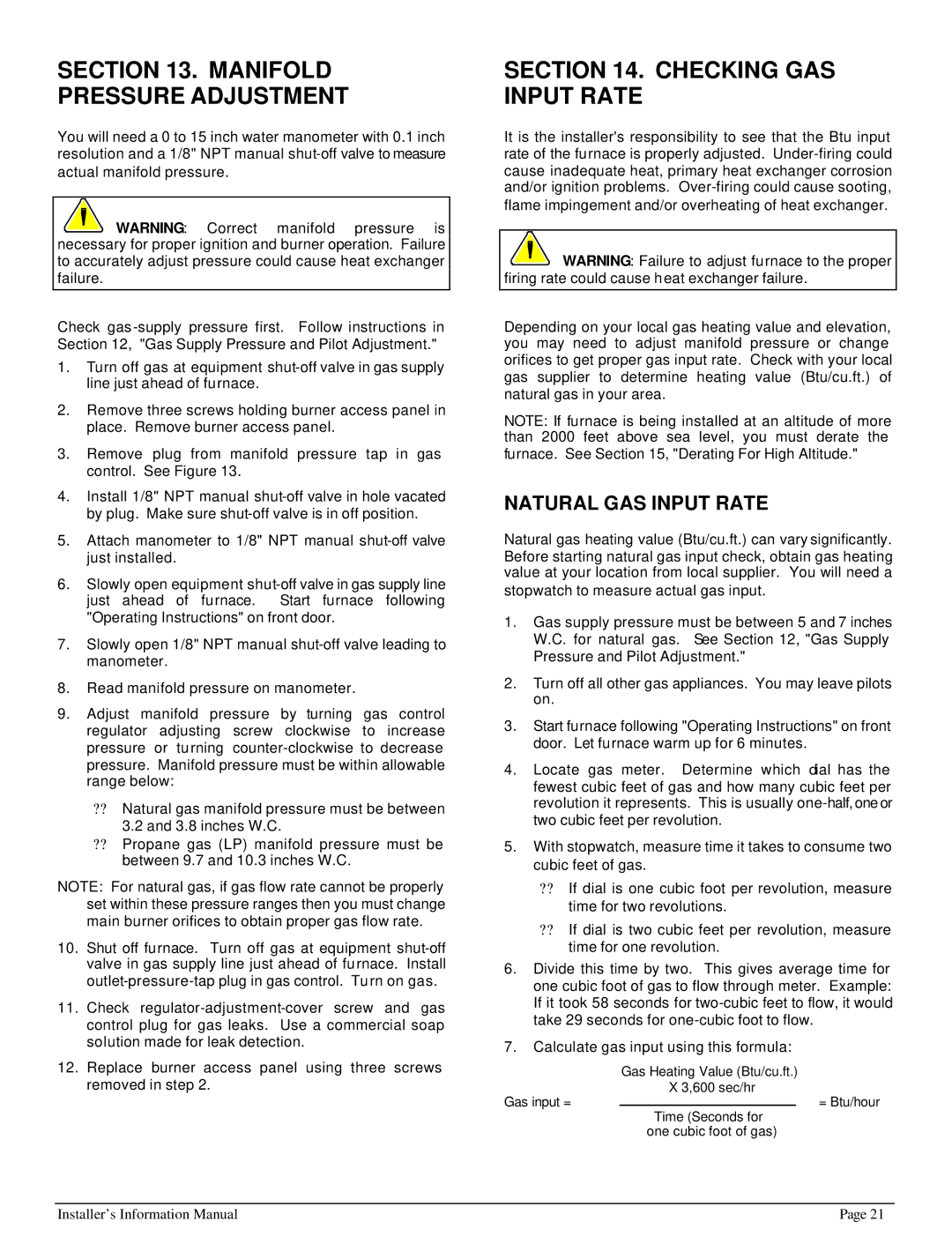
SECTION 13. MANIFOLD
PRESSURE ADJUSTMENT
You will need a 0 to 15 inch water manometer with 0.1 inch resolution and a 1/8" NPT manual
![]() WARNING: Correct manifold pressure is necessary for proper ignition and burner operation. Failure to accurately adjust pressure could cause heat exchanger failure.
WARNING: Correct manifold pressure is necessary for proper ignition and burner operation. Failure to accurately adjust pressure could cause heat exchanger failure.
Check gas
1.Turn off gas at equipment
2.Remove three screws holding burner access panel in place. Remove burner access panel.
3.Remove plug from manifold pressure tap in gas control. See Figure 13.
4.Install 1/8" NPT manual
5.Attach manometer to 1/8" NPT manual
6.Slowly open equipment
7.Slowly open 1/8" NPT manual
8.Read manifold pressure on manometer.
9.Adjust manifold pressure by turning gas control regulator adjusting screw clockwise to increase pressure or turning
??Natural gas manifold pressure must be between 3.2 and 3.8 inches W.C.
??Propane gas (LP) manifold pressure must be between 9.7 and 10.3 inches W.C.
NOTE: For natural gas, if gas flow rate cannot be properly set within these pressure ranges then you must change main burner orifices to obtain proper gas flow rate.
10.Shut off furnace. Turn off gas at equipment
11.Check
12.Replace burner access panel using three screws removed in step 2.
SECTION 14. CHECKING GAS INPUT RATE
It is the installer's responsibility to see that the Btu input rate of the furnace is properly adjusted.
![]() WARNING: Failure to adjust furnace to the proper firing rate could cause heat exchanger failure.
WARNING: Failure to adjust furnace to the proper firing rate could cause heat exchanger failure.
Depending on your local gas heating value and elevation, you may need to adjust manifold pressure or change orifices to get proper gas input rate. Check with your local gas supplier to determine heating value (Btu/cu.ft.) of natural gas in your area.
NOTE: If furnace is being installed at an altitude of more than 2000 feet above sea level, you must derate the furnace. See Section 15, "Derating For High Altitude."
NATURAL GAS INPUT RATE
Natural gas heating value (Btu/cu.ft.) can vary significantly. Before starting natural gas input check, obtain gas heating value at your location from local supplier. You will need a stopwatch to measure actual gas input.
1.Gas supply pressure must be between 5 and 7 inches W.C. for natural gas. See Section 12, "Gas Supply Pressure and Pilot Adjustment."
2.Turn off all other gas appliances. You may leave pilots on.
3.Start furnace following "Operating Instructions" on front door. Let furnace warm up for 6 minutes.
4.Locate gas meter. Determine which dial has the fewest cubic feet of gas and how many cubic feet per revolution it represents. This is usually
5.With stopwatch, measure time it takes to consume two cubic feet of gas.
??If dial is one cubic foot per revolution, measure time for two revolutions.
??If dial is two cubic feet per revolution, measure time for one revolution.
6.Divide this time by two. This gives average time for one cubic foot of gas to flow through meter. Example: If it took 58 seconds for
7.Calculate gas input using this formula:
| Gas Heating Value (Btu/cu.ft.) | |
| X 3,600 sec/hr | |
Gas input = |
| = Btu/hour |
| Time (Seconds for | |
| one cubic foot of gas) | |
Installer’s Information Manual | Page 21 |
